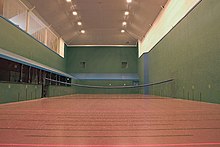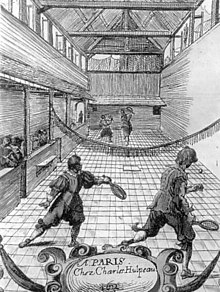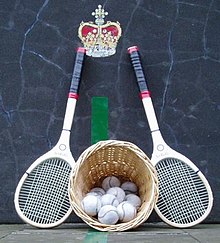Jeu de Paume

Jeu de Paume ( French for "playing with the palm of the hand") was a forerunner of tennis , the game of which was alreadydocumentedin cloisters in the Middle Ages . Like squash, it is played with walls. A detailed description of its origin can be found in the history of tennis . Jeu de paume was first mentioned in 1250 when monks were banned from playing against lay people. By counting the points exactly, regardless of rank or status, it can be considered one of the first modern sports.
Jeu de Paume was anOlympic discipline in London in 1908 and a demonstration sportat the 1924 Games in Paris and 1928 in Amsterdam . The only Olympic champion in the history of this sport is the American George Jay Gould II .
Today this form of tennis is only practiced by around 10,000 athletes, around a third of whom are women. They are spread over almost 50 courts in Great Britain ( Real Tennis ), the United States ( Court Tennis ), Australia ( Royal Tennis ) and France ( Jeu de Paume ). Contrary to what the French name suggests, Jeu de Paume is usually played with a wooden club, the origins of the game being played with the bare palm or with gloves.
The world championships are held every two years. The four best players in the world rankings (with the exception of the reigning world champion) determine the challenger, who then competes against the defending champion in a match over seven sets of wins within three days. The Australian Robert Fahey has been world champion in this sport since 1994 . Fahey is the only player in this sport to be listed as a professional.
equipment
bat
The rackets usually consist of a wooden frame with an asymmetrical nylon-covered head of max. 241.3 mm (9.5 ″) length and 177.8 mm (7 ″) width. The total length of the racket is max. 685.8 mm (27 ").
Balls
Hand-sewn felt balls with a cork core are used as balls. The diameter must be between 61.9 mm (2 7/16 ″) and 65.1 mm (2 9/16 ″) and the weight between 70.9 g (2.5 OZ) and 78 g (2.75 OZ) be.
matchfield
The playing fields are not standardized, but are between 33.53 × 11.89 m (110 × 39 ft) and 29.26 × 9.75 m (96 × 32 ft) in size and twice asymmetrical. The hall in which this game was played is also known as the Jeu de Paume (German " Ballhaus ").
literature
- Heiner Gillmeister: Artists without a network. The medieval tennis players . In: magazine for game culture . ( Full text as PDF ).
- Jean-Michel Mehl: Les jeux au royaume de France. You XIIIe au début du XVIe siècle (= Nouvelles études historiques ). Fayard, Paris 1990, ISBN 2-213-02591-6 (also dissertation, University of Paris-Nanterre 1988).
- Theo Stemmler: From Jeu de paume to tennis . Insel Verlag, Frankfurt am Main 1988, ISBN 3-458-19076-7 .
- Morys Bruce : The JT Faber Book of Tennis and Rackets . Quiller Press, London 2001, ISBN 1-899163-62-X .
Web links
Individual evidence
- ^ Jean-Michel Mehl: Le jeu de paume: un élement de la sociabilité aristocratique à la fin du moyen age et au début de la renaissance. In: Sport / Histoire. 1, 1, 1988, pp. 19-30.
- ↑ Arnd Krüger , John McClelland (ed.): The beginnings of modern sports in the Renaissance. ( Articles and Sources on Sport and Society, Volume 2.) Arena Publ., London 1984, ISBN 0-902175-45-9 .
- ↑ Latin Palma
- ↑ Irtpa.com: Historical Results, accessed 29 January 2015.
- ↑ irtpa.com


